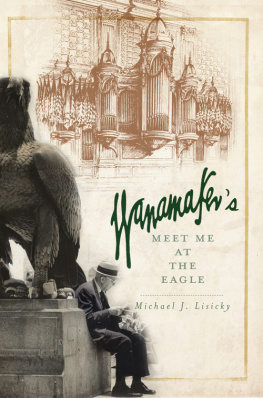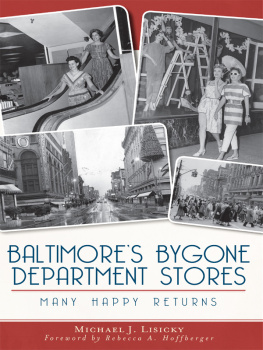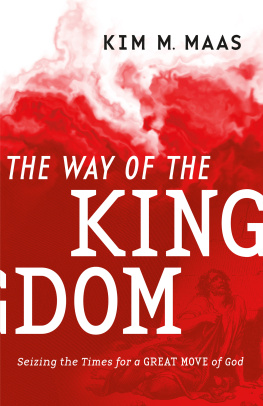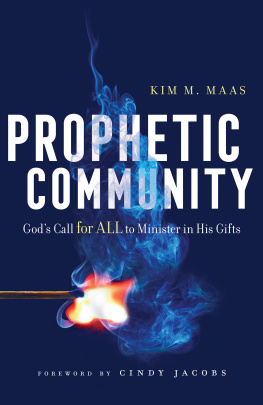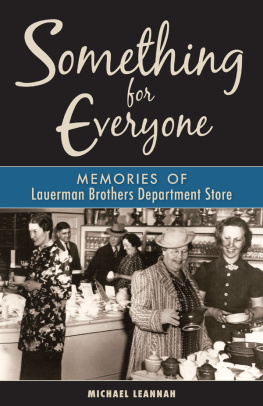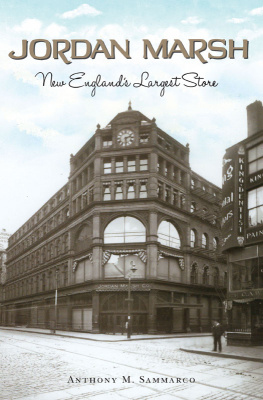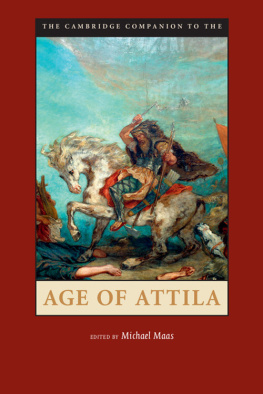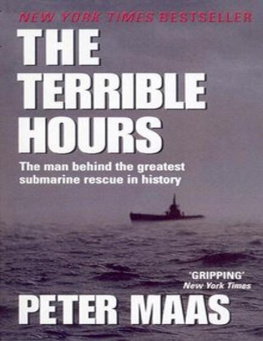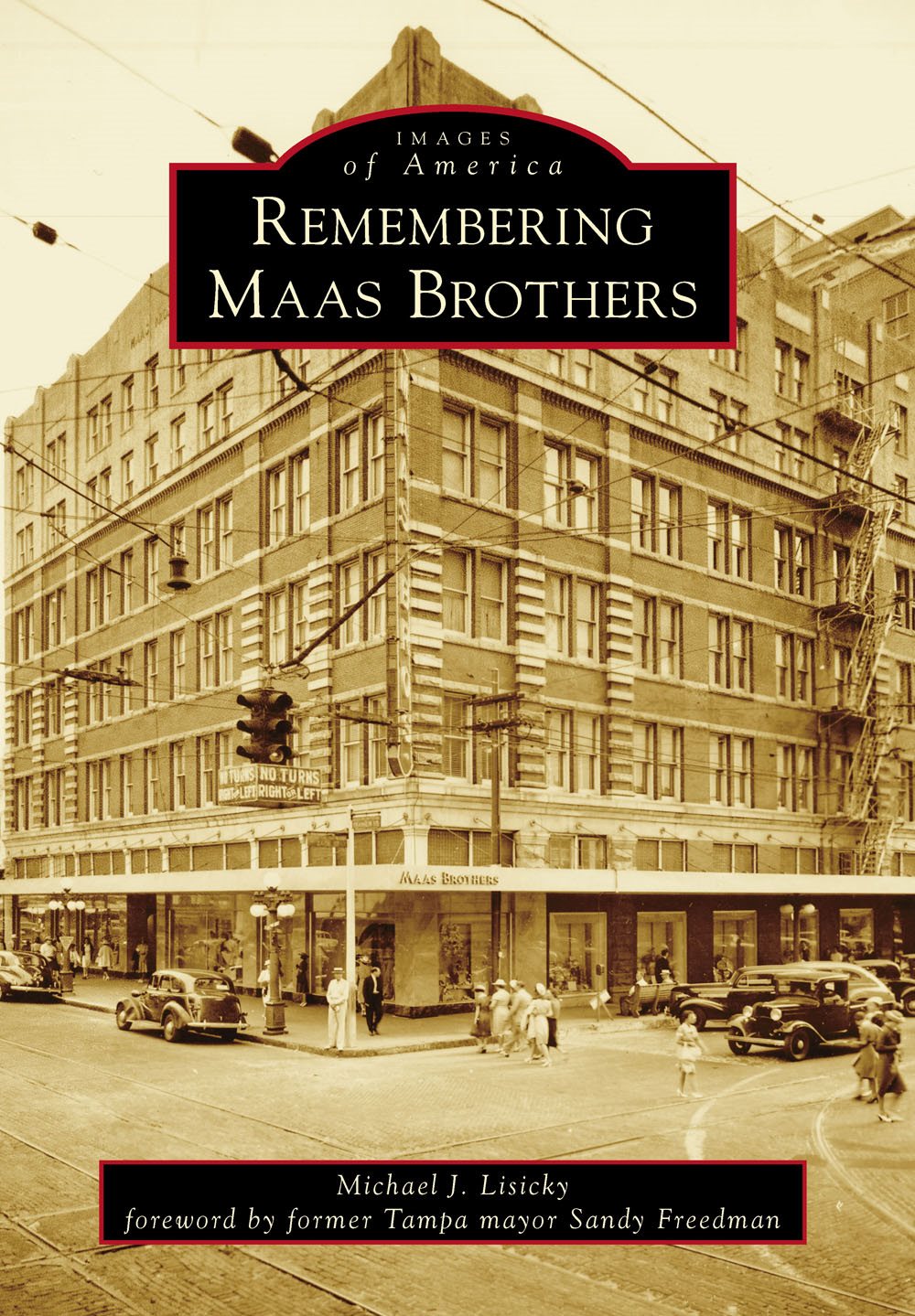
IMAGES
of America
REMEMBERING
MAAS BROTHERS
ON THE COVER: The downtown Tampa Mass Brothers proudly stood at the corner of Franklin and Zach Streets. (Courtesy of the TampaHillsborough County Public Library.)
IMAGES
of America
REMEMBERING
MAAS BROTHERS
Michael J. Lisicky
foreword by former Tampa mayor Sandy Freedman

Copyright 2015 by Michael J. Lisicky
ISBN 978-1-4671-1473-8
Ebook ISBN 9781439653814
Published by Arcadia Publishing
Charleston, South Carolina
Library of Congress Control Number: 2015936189
For all general information, please contact Arcadia Publishing:
Telephone 843-853-2070
Fax 843-853-0044
E-mail
For customer service and orders:
Toll-Free 1-888-313-2665
Visit us on the Internet at www.arcadiapublishing.com
CONTENTS
FOREWORD
Everybody has a story about Maas Brothers. We had a personal relationship with that downtown Tampa store. We knew the salespeople, and some of them took care of us and then took care of our children. I personally remember the makeup counter because it was the first place that I ever bought cosmetics. I had so many fond memories of that store. My father had a fine-jewelry store that was located across the street from the Tampa Theater. Maas Brothers was so much a part of my growing up, and I never heard anybody talk badly about it.
To this day, people still remember the cinnamon twists. We did not have these types of things in those days. Maas Brothers did the department store thing, but it also had this nice little restaurant. My father ate at Maas Brothers almost every day, and I remember going home many a day with a container of those cinnamon twists.
I had been to the St. Petersburg store, but it was not the same as the downtown Tampa location. I do not think that they considered it to be their store as we did with our store in Tampa. The downtown Tampa store was just a cozier space. Besides, Tampa is the center of the region, and it will always be the commercial hub. St. Petersburg has changed dramatically over the years, and it has now become a significantly younger community. But in the past, we were not nearly as mobile as we are now. We just did not have the road network. If you lived in Tampa, you did not need to shop in St. Petersburg and vice-versa.
Downtown Tampa eventually transitioned, and there was a huge flight to Westshore. But I stayed loyal to the downtown store until they closed their doors. There were always reasons to go there. Besides, I worked at city hall. In all fairness, there would not be the other stores if it were not for the Tampa store. It was the mother store.
Sandy Freedman, former Tampa mayor
ACKNOWLEDGMENTS
I have learned that books such as these are not possible without the help of special people and archival institutions. Many photographs and pieces of Maas Brothers ephemera are still alive and maintained well under the care of the following people and organizations: David Parsons and the TampaHillsborough County Public Library and Tampa Bay History Center, Ann Wikoff and the St. Petersburg Museum of History, Matthew Knight and the Special and Digital Collections at the University of South Florida, Adam Watson and the Florida State Archives Florida Memory Project, Kevin Logan at the Lakeland Public Library Special Collections Department, and the Manatee County Public Library Digital Collection. A message of deep appreciation goes to Lisa Lichtenberg, Richard Stein, Ron Rodriguez, Megan Weber, and Sue Meadows for sharing their own personal photographs. All of the above institutions and people are credited for their respective contributions. Any images that are not credited are part of my personal collection. I also must cite the great reference Maas Brothers: The Tradition Continues, compiled by Jeffrey E. Plourde. If you are a Maas Brothers fanatic, find it and read it.
In order to tell a story properly, you need memories and stories that will complement these images. A big thank-you goes to former Tampa mayor Sandy Freedman and the assistance of Debra Rotolo for her introductory thoughts and Audrey Maas Shine and all of the many Maas Brothers executives and employees who came forward and shared their experiences with this beloved institution. I cannot thank Lisa Lichtenberg enough for spearheading this effort. But I must also give special thanks to some people who answered my call and opened up their memories and contacts to me, especially Robert Stein, Ron Rodriguez, Chuck James, Ann Ruppert, Robert Walton, and Talbot Boudreau. Please enjoy reading their thoughts and those from many others throughout this book.
It is always comforting to know that I am not the only person who still holds these places close to my heart, for reasons that I cannot always explain. And it is comforting to know that I have a wife and daughter who are extremely patient and supportive of this obsession and passion.

This image, courtesy of Lisa Lichtenberg, is a collage of the people and places of Maas Brothers over the years.
INTRODUCTION
Only a handful of American cities were dominated solely by one classic department store. Columbus had Lazarus, Detroit had Hudsons, Miami had Burdines, Houston had Foleys, and Tampa had Maas Brothers.
The typical department-store rivalries simply did not exist in Tampa. There was no Macys versus Gimbels feud. The dispute about Bostons real Santa Claus residing at Filenes or Jordan Marsh never occurred. The superiority of Pittsburghs Kaufmanns or Joseph Hornes department-store restaurants was never debated.
Although there were other shopping options, Tampa did not necessarily need or want another major department store in its hometown. The Tampa community, and ultimately the entire region, depended on Maas Brothers for its shopping and social needs.
Over time, Maas Brothers developed into much more than a downtown Tampa institution. In 1948, the company opened a large streamlined operation in downtown St. Petersburg and became a part of that citys fabric and identity. Its success brought the Maas name to additional locations such as Lakeland, Sarasota, and Clearwater. By the 1970s, Maas Brothers was located throughout Floridas West Coast, but it never developed on the states East Coast. The two coasts had separate identities with separate tastes. Florida was a big state with unique cities. Miami was not Tampa, and Tampa was not Jacksonville.
I always associated Maas Brothers with Tampa Bay, and vice-versa. The stores were not ostentatious. They had a distinctly casual atmosphere, much like the areas residents. When Burdines, Gayfers, Robinsons, and Iveys came to the area, they were outsiders. These intruders tried to challenge Maas Brothers dominance, but it was an uphill battle. It is not surprising; the Tampa Bay region was loyal to its hometown store.
Even to this day, many Tampa Bay residents mourn the loss of their favorite store. They are not alone. Most American cities have lost their favorite local store. In recent years, retail analysts have questioned the relevance of todays brick-and-mortar businesses. Stores have transitioned into showrooms, and a large number of retail transactions are now handled electronically.
When Maas Brothers closed, distinctive traditions ended. Tampa Bay shoppers could no longer purchase cinnamon twists, wait in long lines at the Blockbuster Sale in St. Petersburg, or call Jane Lee for shopping assistance. They could not spend a Saturday shopping on Franklin Street or have lunch in the Neptune Room, and there were no movies at the Tampa Theater.
Next page

